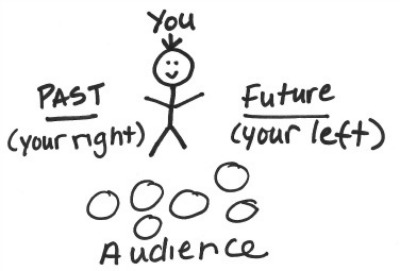I could tell they were all nervous.
Julia’s hands shook. Justin kept his left hand in his pocket. Darcy flailed her hands.
As each student came up to give their first speech in my class, their body language, and especially their hands telegraphed their speech jitters.
- Hand in pocket
- Clasped hands
- Flailing hands
- Fig leaf position
- Hanging on to the lectern
- Busy hands (playing with notes or pen)
- T-Rex arms (arms close to sides, bent at 90 degrees, with hands dangling in front of body)
And except for Julia, who was well aware that her hands were shaking, none of the other students realized what they were doing with their hands.
What should you do with your hands when speaking?
I suggest a “default” position of simply having your hands hang down at your sides when you are not using them to gesture. As a former, T-Rex-style speaker, I had to consciously leave my hands at my side. Once you have reduced the distracting hand gestures, you can usually just gesture naturally. Probably the best way to determine what you might change is to watch yourself on video. Or, if you are involved in a Toastmaster club, ask your evaluator (or even another person) to specifically note what you do with your hands.
Where to stand?
Don’t hide behind the lectern, at least not the whole time. Move away now and then, especially when telling a story.
You should start and end your speech standing centered before your audience, but you can move to other parts of the stage for different points, to set a scene and to include the audience members, if on a large stage.
Remember to consider your body language and movement from the audience’s perspective. Your right is their left, hence you should gesture to your right to refer to the past and to your left to refer to the future.
If you have a presentation screen and can choose where to stand, have the screen on your left (the audience’s right). People read from left to right, so if you are in the “start” position for reading, their eyes have to do less shifting.
How to stand?
Have your feet about a shoulder-width apart with one foot slightly ahead of the other for maximum stability. You will want to have your weight evenly balanced for good posture and to allow you to step easily in either direction.
Practice good posture. Not only will you look more confident, but you will look taller and slimmer, too. Plus it will be easier to breathe. Don’t forget to breathe! As I am getting ready to speak, I will elongate my posture by imagining a string is pulling the top of my head, my chest and my pelvis, and then I will somewhat relax the posture.
And a final tip, from the 2001 Champion of World Speaking, Darren LaCroix:
Don’t Mix Up Your Holograms. Where ever you tell a story the audience makes a “hologram” of the scene. Be careful not to mix up your holograms. Darren gave the example of a speaker who told a story in which he knelt at his father’s coffin. Later in the speech, he told a story about his family going on a picnic. The speaker acted out spreading the picnic blanket in the same spot as–you guessed it–the coffin! Have your stories at different parts on the stage. Then you also can refer back to them with pointing to that same spot.
Do you have some tips on how to stand and move with power and purpose?


